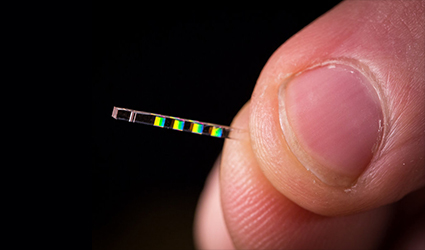Particle Accelerators on a Chip
July 20, 2018
Source: NPR
 703
703

The particle accelerators are usually considered giant structures, working at high speed with enormous energy. But the scientists from Stanford University in California switched from big thinking to tiny designs. They want to create an accelerator chip, which could revolutionize medical therapy. Robert Byer, a physicist at Stanford University, had the idea to add energy to electrons as they travel through a small channel in a semiconductor chip using a laser.
Robert Byer said, "We need to focus the electrons; We need to bunch them so they surf the wavelength of light right at the crest, so they get the maximum acceleration."
Peter Hommelhoff from the Friedrich-Alexander-Universität Erlangen-Nürnberg in Germany said, "The acceleration channel is very narrow, so you have to generate a very, very narrow electron beam that you can send through the channel.”
Joel England, a physicist from the SLAC National Accelerator Laboratory said, "Depending on how much progress gets made, I would say five to 10 years; One of the applications could be to take one of the fairly bulky, 10,000-pound accelerator devices that's used in hospitals for radiation therapy and make that into something that's chip-sized."
Robert Byer stated, "Early on, lasers were big — and they were inefficient and they took all the power and water in your building to operate them; They got more and more efficient because we converted to semiconductor lasers and solid-state lasers — and all of a sudden, lasers then became everywhere."
Though it might take a decade or more, Robert Byer hopes that the smaller accelerators will become a reality.
By DduRead more on
- Things to Know before Buying Newborn Baby Incubators March 31, 2022
- Highly Resistant Food Poisoning Bug Responds to Antibiotics September 6, 2018
- Smartphone Based Diagnosis to Identify Mosquitoes Transmitting Infection September 5, 2018
- 3 Natural Plant Extracts Manufacturers on Drugdu.com September 4, 2018
- Shenzhen Chuanggan – Health Assessment Facility Supplier September 4, 2018
your submission has already been received.
OK
Subscribe
Please enter a valid Email address!
Submit
The most relevant industry news & insight will be sent to you every two weeks.



